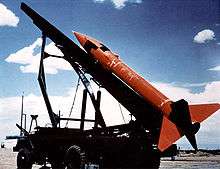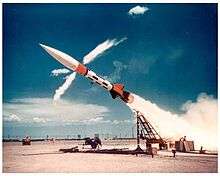MGR-1 Honest John
| MGR-1 Honest John | |
|---|---|
 An "Honest John" rocket on truck | |
| Type | Nuclear-capable surface-to-surface missile |
| Place of origin | United States |
| Service history | |
| In service | 1953-85 |
| Used by | Belgium, Britain, Canada, Denmark, France, Germany, Greece, Italy, the Netherlands, Norway, South Korea, Taiwan, and Turkey |
| Wars | Cold War |
| Production history | |
| Manufacturer | Douglas Airplane Company |
| Specifications | |
| Weight | 2,640 kg (5,820 lb) |
| Length | 831 cm (327 in) |
| length | 501.5 cm (197.4 in) |
| Diameter | 76 centimetres |
|
| |
Operational range | 24.8 kilometres |

The MGR-1 Honest John rocket was the first nuclear-capable surface-to-surface missile in the United States arsenal.[notes 1] Designated Artillery Rocket XM31, the first such rocket was tested 29 June 1951 and the first production rounds were delivered in January 1953. The designator was changed to M31 in September 1953. The first Army units received their rockets by year's end and Honest John battalions were deployed in Europe in early 1954. Alternatively, the rocket was designed to be capable of carrying an ordinary high-explosive warhead weighing 680 kilograms (1,500 lb), even though that was not the primary purpose for which it was originally envisioned.
History and development

Developed at Redstone Arsenal, Alabama, Honest John was a large but simple fin-stabilized, unguided artillery rocket weighing 2,640 kilograms (5,820 lb) in its initial M-31 nuclear-armed version. Mounted on the back of a truck, HJ was aimed in much the same way as a cannon and then fired up an elevated ramp, igniting four small spin rockets as it cleared the end of the ramp. The M-31 had a range of 24.8 kilometres (15.4 mi) with a 20 kiloton nuclear warhead and was also capable of carrying a 680 kilograms (1,500 lb) conventional warhead. Early tests exhibited more scatter on target than was acceptable when HJ was conventionally armed. Development of an upgraded Honest John, M-50, was undertaken to improve accuracy and extend range. The size of the fins was greatly reduced to eliminate “weathercocking” (the tendency of crosswinds to turn a rocket to face into the wind). Increased spin was applied to restore the positive stability margin that was lost when fin size was reduced. The improved M-50, with the smaller fins and more “rifling”, had a maximum range of 30+ miles with a scatter on target of only 230 metres (250 yd), demonstrating an accuracy approaching that of tube artillery. Honest John was manufactured by the Douglas Airplane Company of Santa Monica, California.[1]
The M31 consisted of a truck-mounted, unguided, solid-fueled rocket transported in three separate parts. Before launch they were assembled in the field, mounted on an M289 launcher and aimed and fired in about 5 minutes. The rocket was originally outfitted with a W7 variable yield nuclear warhead with a yield of up to 20 kilotons of TNT (84 TJ) and later a W31 warhead with three variants was deployed with yields of 2, 10 or 30 kt (8.4, 41.8 or 125.5 TJ) in 1959. There was a W31 variant of 20 kt (84 TJ) used in the Nike Hercules antiaircraft system exclusively. M-31 had a range between 5.5 and 24.8 km (3.4 and 15.4 mi).
In the 1960s Sarin nerve gas cluster munitions were also available for Honest John launch; designed to be interchangeable for use with the either Honest John or MGM-5 Corporal. Initially the M79 (E19R1) GB cluster warhead, containing 356 M134 (E130R1) bomblets for the M31A1C Honest John. The production model was the M190 (E19R2) GB cluster warhead, containing 356 M139 (E130R2) bomblets when the M31A1C was phased out in favor of the XM50 Honest John. Under nominal conditions it had an MAE of 0.9 square kilometers.[2]
The two basic versions of Honest John were:
- MGR-1A (M31) was 8.31 metres (27 ft 3 in) long, had an engine diameter of 58.10 centimetres (22.875 in), a warhead diameter of 76 centimetres (30 in), a span of 260 centimetres (104 in), weighed 2,640 kilograms (5,820 lb) (nuclear), and had a maximum range of 24.8 kilometres (15.4 mi). The Hercules Powder Company X-202 rocket motor was 5.015 metres (197.44 in) long, weighed 1,786 kilograms (3,937 lb), and had 401.79 kN (90,325 lbf) average thrust.[3]
- MGR-1B (M50) was 7.5827 metres (24 ft 10.53 in) long, had an engine diameter of 58 centimetres (22.8 in), a warhead diameter of 76 centimetres (30 in), a span of 140 centimetres (56 in), weighed 1,965 kilograms (4,332 lb) (nuclear), and had twice the range of the M31. An improved propellant formulation gave the rocket motor 670 kN (150,000 lbf) thrust.
Production of the MGR-1 variants finished in 1965 with a total production run of more than 7,000 rockets. Honest John’s bulbous nose and distinctive truck-mounted launch ramp made it an easily recognized symbol of the Cold War at Army bases world-wide and National Guard armories at home. Even though HJ was unguided and the first U.S. nuclear ballistic missile, it had a longer service life than all other U.S. ballistic missiles except Minuteman. The system was replaced with the MGM-52 Lance missile in 1973, but was deployed with NATO units in Europe until 1985 and National Guard units in the United States as late as 1982. Conventionally armed Honest John remained in the arsenals of Greece, Turkey and South Korea until at least the late 1990s.
By the time the last Honest Johns were withdrawn from Europe in 1985, the rocket had served with the military forces of Belgium, Britain, Canada, Denmark (non-nuclear), France, Germany, Greece, Italy, the Netherlands, Norway (non-nuclear), South Korea, Taiwan (non-nuclear), and Turkey.[4]
Origin of name
In late 1950, Major General Holger Toftoy was a colonel overseeing the development of the rocket. The project was in danger of cancellation "on the grounds that such a large unguided rocket could not possibly have had the accuracy to justify further funds."[5] On a trip to White Sands Missile Range, Toftoy met a Texan man who was prone to making unbelievable statements. Whenever anyone expressed doubt about the man's claims, he would respond, "Why, around these parts, I'm called 'Honest John!'" Because the project was being questioned, Toftoy felt that the nickname was appropriate for the rocket and suggested the name to his superiors.[5]
Support vehicles
.jpg)
Vehicles used with Honest John
- M33 trailer, launcher,
- M46 truck, heating and tie down unit (G744)
- M289 truck, rocket launcher, (M139 truck) (G744),
- M329 trailer, rocket transporter, (G821)
- M386 Truck, Rocket, 762mm, short launch rail, 5-ton (M139 truck)
- M405 handling unit, trailer mounted,
- M465 cart assembly, transport, 762mm rocket,
Survivors
Canada
- CFB Petawawa Military Museum CFB Petawawa, Petawawa, Ontario.
- The Central Museum of The Royal Regiment of Canadian Artillery, Shilo Manitoba
Denmark
Netherlands
United Kingdom
United States

- 3rd Cavalry Museum, 1st Cav Museum, Fort Hood, Texas
- 45th Infantry Museum, Oklahoma City, Oklahoma
- Air Force Space & Missile Museum, Cape Canaveral Air Force Station, Florida
- American Armoured Foundation, Inc. Tank & Ordnance War Memorial Museum, Danville, Virginia
- Bedford, Indiana, displayed outside a Military surplus store, at the Southwest corner of US-50/IN-37 and IN-450 (Google Maps streetview link ).
- Camp Atterbury Military Museum, Camp Atterbury, Indiana
- Carolinas Aviation Museum, Charlotte, North Carolina (Two missiles are on display - both came from the Florence Air & Missile Museum)
- Crestwood, Illinois, on display at municipal Park "missile in the park"
- Combat Air Museum, Topeka, Kansas
- Fort Lewis Museum, Fort Lewis, Washington
- Field Artillery Museum, Fort Sill, Oklahoma
- National Atomic Museum, Kirtland AFB, Albuquerque, New Mexico
- Rock Island Arsenal, Arsenal Island, between Iowa and Illinois
- Texas Military Forces Museum at Camp Mabry, Austin, Texas
- Underwood Public School, Underwood, Minnesota.[6]
- United States Space & Rocket Center, Huntsville, Alabama
- Yuma Proving Ground, Yuma, Arizona
- Milledgeville High School, Milledgeville Illinois (home of the Milledgeville Missiles)
- Miami Central High School Miami, Florida Home of the "ROCKETS".
- A.C. Reynolds High School Asheville, North Carolina Home of the "ROCKETS".
- Outdoor display, Spokane, Washington - southwest corner of Sanson and Market in Hillyard neighborhood
- Outdoor display, St. Albans Roadside Park, St. Albans, West Virginia
- Outdoor display, White Sands Missile Range Museum, New Mexico [7]
Operators


_5.jpg)
Former operators
Canada adopted the MGR-1B with the 1 Kiloton W31 warhead. Four units were assigned to 1 Surface to Surface Missile Battery, Royal Canadian Artillery at Hemer, Germany under 4 CIBG. Two to four units were supplied to 2 SSM Battery at Camp / CFB Shilo in Manitoba for training. These units were formed in September 1960. 1SSM maintained very high readiness and able to deploy to firing positions quickly. Their ability to maintain Camouflage kept even elite NATO special forces from locating them in excercies. 1SSM was authorized to wear the black scarf of the Congreve rocket gunners. Canada disbanded the Honest John batteries in mid 1970 without replacement.,[8][9]
- Norwegian Army (1961–65)
See also
Notes
- ↑ The first nuclear-authorized guided missile was the MGM-5 Corporal.
References
- ↑ Gibson, Nuclear Weapons of the United States, pp. 177-179, 1996
- ↑ Kirby,Reid, "The CB Battlefield Legacy", Army Chemical Review July–December 2006, pp. 25 - 29.
- ↑ http://www.astronautix.com/articles/doulants/htm Bedard, Double Base Solid Propellants, "Major Hercules Motors", p. 3, 2009
- ↑ General Dynamics, Free World Tactical Missile Systems (Pomona, CA: General Dynamics, June 1973) p.251; Jane's Weapon Systems 1987-1988 (London: Jane's, 1987) p.127.
- 1 2 McKenney, Janice E. (2007). The organizational history of field artillery 1775-2003. Washington, D.C.: Center of Military History, United States Army. p. 212. ISBN 9780160771149.
- ↑ http://www.ci.underwood.mn.us/sights.html
- ↑ http://www.wsmr-history.org/HonestJohn.htm
- ↑ http://www.canadiansoldiers.com/corpsbranches/royalregimentofcanadianartillery.htm
- ↑ The Honest John in Canadian Service - John Davidson, Canada's Weapons of War Series, WOW030, A5 size softback, 24 pages,ISBN 978-1-894581-71-4, Service Publications, Canada
External links
| Wikimedia Commons has media related to MGR-1 Honest John. |
- http://www.designation-systems.net/dusrm/r-1.html
- http://www.astronautix.com/lvs/hontjohn.htm
- Redstone Arsenal (Alabama) (includes declassified military monograph on the Honest John, chronology, pictures, and a movie of an Honest John firing)
- Weapons of the Field Artillery - Part 3, U.S. Military Documentary, Film TF6 3646, 1965
- Honest John Missile Base in Germany http://www.herzobase.org
- http://www.olive-drab.com/idphoto/id_photos_m39_missiletrk.php launchers
